As an Amazon Associate I earn from qualifying purchases.
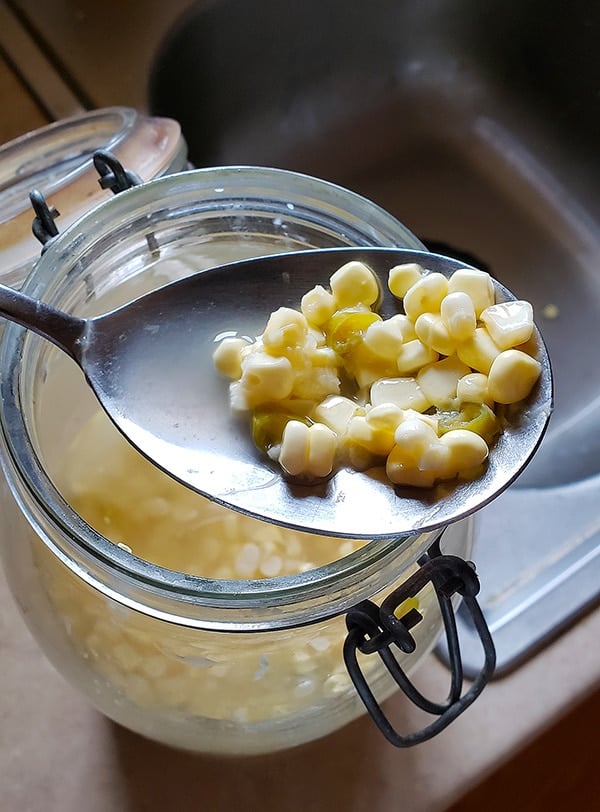
Anyone who knows me knows that I am always looking for some new thing to ferment, preserve or pickle. So when I learned about Southern sour corn, I had to make it.
I wish I had some great story to tell about how I first ate this lacto-fermented sweet corn in some West Virginia diner, maybe on top of some chicken fried steak with some crowder peas. Actually, that sounds amazing and I’ll have to make it.
But no, I learned about this Appalachian specialty in Ronni Lundy’s fantastic cookbook Victuals: An Appalachian Journey, with Recipes. I’ve been cooking a lot from this book lately, and I simply cannot overstate how wonderful a book it is. If you like real Southern food, you need to buy this book.
Sour corn is to corn what sauerkraut is to cabbage. Same deal. Stupid easy to make. Corn, water, salt, and maybe something extra to make it yours. In my case, thinly sliced green cayenne chiles.
A few things you need to know.
- Use Diamond Crystal kosher salt if you want to use my volumetric measurements; other salts will give you a different brine strength. Or you can weigh the amount of corn + water in grams and then add out 2 percent of that weight to the water to make a brine.
- Keep the corn below the level of the water. Floaters will mold up fast. You can use a clean plastic bag will with more brine to do this, or use a pickling plate if you have a crock, or a small regular plate if you have one that works.
- Mold happens. When you see it, skim it off. Usually you’ll get a ropey, icky white mold, mother-of-vinegarish thing. It’s not harmful, but you want to skim it off as the mold can get into your brine and alter the flavor a bit. It’s still fine.
- Keep it simple. Add one or two other things to your sour corn, but remember this is a base condiment, not a finished relish. Of course, you can ferment a full relish if you want, but that’s a different recipe.
How to use your sour corn? Hell, it’s great as a snack. But I like it as a sort of Southern salsa, alongside the aforementioned chicken fried steak, or any other quickly cooked meat; as a side dish to my buttermilk fried quail springs to mind.
I know other people cross cultures and literally use sour corn as a salsa on tacos, which is also excellent. When you come up with a cool way to use it, do me a favor and post it up in the comments section below. Enjoy!
Sour Corn
Ingredients
- 2 dozen ears sweet corn, kernels removed
- 1 to 5 green cayenne or other hot chiles, sliced very thin (optional)
- 2 tablespoons pickling spice (mustard, coriander, black pepper, etc.) (optional)
- 5 tablespoons Diamond Crystal kosher salt
- 2 quarts water
Instructions
- Put the corn and chiles in clean quart Mason jars or crocks, or some other non-reactive container, which means no galvanized steel or aluminum. Make sure there is sufficient headspace to keep the corn below the level of the brine.
- Mix the salt and spices, if using, with the water and stir until the salt dissolves. Pour over the brine and any spices you might be using. Place something to keep the corn from floating. I use a plastic bag filled with some more brine.
- Put the whole shebang in a cool place, like a basement, or a quiet, dark corner -- any place below 75F or so. Let this ferment for at least 5 days, and up to 2 weeks. Taste the corn after 5 days and let it get as sour as you want it.
- When it's ready, move the jars to a cooler place to store for as long as you need. It'll keep for months in the fridge, although you will need to skim the mold that will form on top.
Nutrition
Nutrition information is automatically calculated, so should only be used as an approximation.
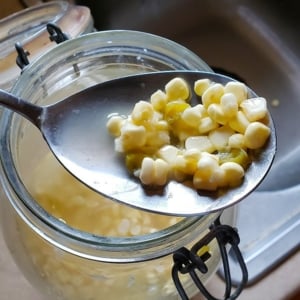
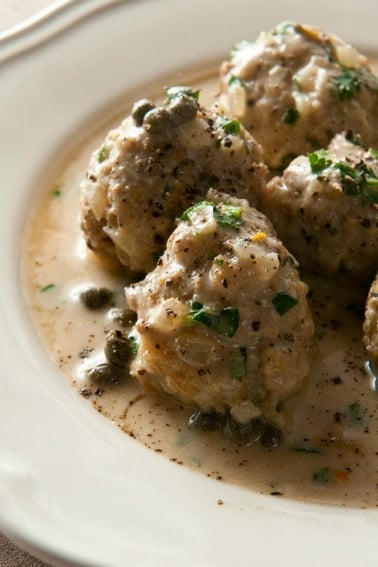
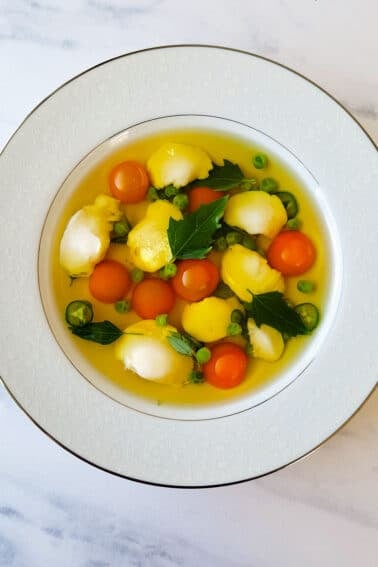

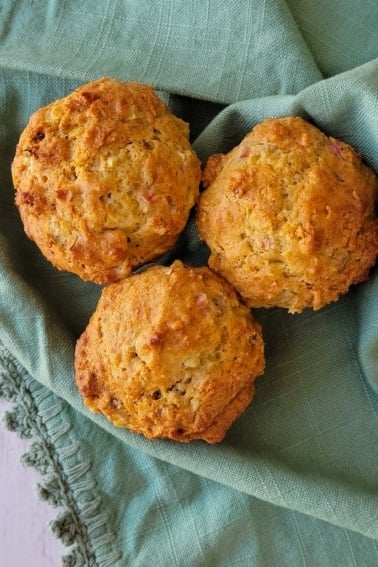
Hi Hank, thanks for this recipe! I’m eager to test it out this week.
Since it’s still too early for buying fresh corn cobs, I was wondering if you think that frozen (so thawed out) sweet corn grains can be used for this recipe? Or is it possible that all lacto bacillus is dead on those?
Gabriel: I’ve never tried it with anything but fresh corn. It might require it, but only one way to find out!
this is so tasty, I make it all the time
hi im kind of confused as of what to do if my plan is to just put it into individual mason jars from the start. would i pour the brine to cover the corn then seal it? I grew up on this stuff and it’s a HUGE deal for me to figure this out. I don’t have anyone that knows how to make it around anymore. but I remember these just being i dividual sealed jars. you popped one open discarded the top fizzy part and rinsed your corn or if your hard core just eat it right out of the jar slime and all. lol. I absolutely adore this stuff
Chelsea: I bulk ferment it and then move to jars after it has soured. I keep it in the fridge, but if you have a cool place to store them, like a basement, they should be OK. But remember they will keep fermenting, throwing off gases, so beware of pressure building up in the jars.
Will Himalayan pink salt work for this? This is the only salt that we purchase
Stephanie: Maybe? I have never tried it.
I am so very grateful that you posted this recipe. I’m Appalachian (Ohio River Valley) and pickled corn is something that is very dear to my heart. Alas, it has become almost unheard of. My ancestors that made it are long gone and as it is an acquired taste, no one thought it important enough to master a recipe to keep our culture alive. It’s sad that people are actually ashamed of being Appalachian bc of the hillbilly redneck stereotypes. We are portrayed as ignorant, dirty, perverse, bigoted, Bible beaters that marry our relatives and beat our kids. it’s what Hollywood has made us out to be. So for generations we have been the sweat stain of America and our culture is dying out. you have no idea how happy this makes me.
oh yeah, if you want to eat pickled corn the way I was brought up to eat it you’ll want to Crack a jar open. scoop out the first little bit of frothy foamy corn and throw it out or feed it to your dog’s. then depending on how sour the batch is (the really really good sour corn will be a bit slimey) you’ll want to LIGHTLY rinse the corn in a collander. just to get rid of the slimey texture. unless you’re into that kinda thing. if you want it slimey then just skip the rinse. take the corn and put it in a pot or pan with some bacon and butter and pepper. heat it until the bacon is cooked. and boom you have an amazing side dish that goes great with casseroles. I love to have mine with Hamburger Helper or Chicken and mashed potatoes. I like it cold from the jar too as a snack but cooking it this way transforms it from a condiment into a meal in itself.
again thank you so much for sharing the recipe and I hope anyone who read far enough to see my way of eating pickled corn will try it out.
So excited to find this recipe. My husband’s grandma (Appalachian region of NC) made picked beans and corn for decades. It was fermented just like your recipe and it was a family favorite for sure. She passed away over 13 years ago. She would mix green beans and corn from her garden, combined them with water and salt and made the tangiest delightful sour beans and corn. She would make some batches with jalapeños and some without. She would process the jars when done. Have you ever done that? She made so much at a time and they lasted so much longer that way. I can’t wait to try this out in my crock.
THANKS SO MUCH FOR THE RECIPES! I HAVE MY CITY MODEL SAUERKROCK AND I WANT TO TRY BOTH GARLIC DILL PICKLES AND PICKLED CORN!